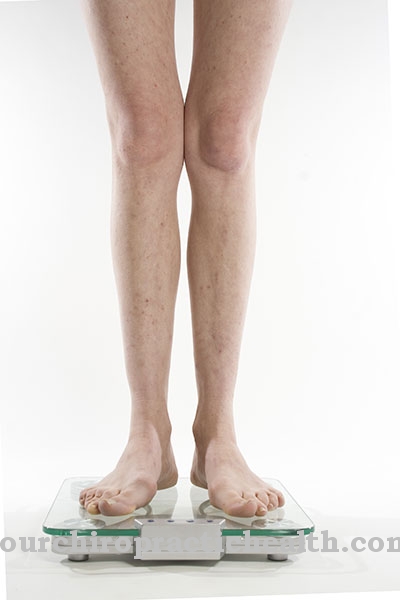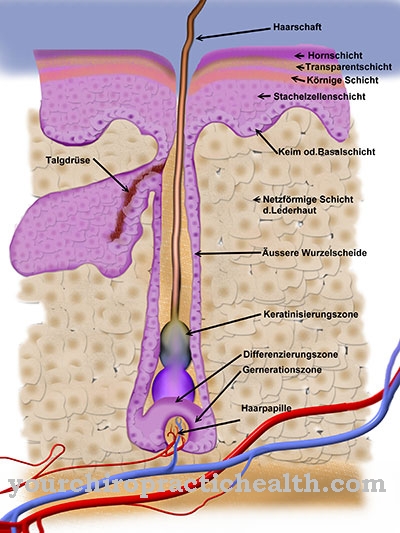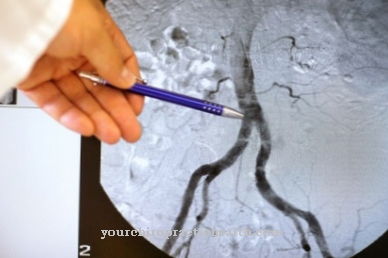At a Cavernous sinus thrombosis the cavernous sinus is blocked by a blood clot or clot. It is a life-threatening disease.
What is cavernous sinus thrombosis?

© Martha Kosthorst - stock.adobe.com
Under the term of Cavernous sinus thrombosis one understands a partial or complete closure of the cavernous sinus.
Of the Cavernous sinus is a venous blood vessel in the brain. It belongs to the sinus durae matris and is located on both sides of the Turkish saddle (Sella turcica). He receives the venous blood from the Sphenoparietal sinus, of the Superior ophtalmic vein and the Inferior ophtalmic vein. In the wall of the cavernous sinus run four cranial nerves and the Internal carotid artery, an artery that supplies the brain. The four cranial nerves are:- Oculomotor nerve
- Ophtalmic nerve
- Maxillary nerve
- Trochlear nerve.
causes
Cavernous sinus thrombosis usually arises from a bacterial inflammation of the sinuses. The pathogens usually reach the frontal sinus via the bloodstream (Frontal sinusitis) or from the sphenoid sinus (Sphenoid sinusitis) to the cavernous sinus. However, bacterial inflammation of the soft tissues of the upper face area can also spread to the cavernous sinus. Possible causative diseases here are boils or erysipelas.
Other causes are mastoiditis and meningitis. If the cause is bacterial, one always speaks of a septic sinus vein thrombosis. A cavernous sinus thrombosis can also be caused by diseases that are associated with increased blood clotting. These include, for example, polycythemia or antithrombin deficiency. Pregnant women are at greater risk of sinus vein thrombosis. Medicines such as hormonal contraceptives or cortisone preparations also increase the risk.
Symptoms, ailments & signs
Cavernous sinus thrombosis is slow to develop. Early signs are tenderness in the corner of the nose and visual disturbances. There may be signs of congestion around the eyes. This affects the side on which the thrombosis is located. The eye is reddened or swollen. It may protrude from the eye socket (exophthalmos).
Due to paralysis of the eye muscles, the eyes can only be moved less. Those affected see double vision. The symptoms are accompanied by unspecific general symptoms such as nausea, vomiting, fever and chills.
The headache increases later. Neck pain can also occur. The pain radiates into the arms or radiates from one temple over the entire forehead to the other temple. Edema occurs in the area of the eyelids and the nasolabial fold. Epileptic seizures may occur. Psychotic symptoms or changes in personality are also possible.
In the full screen, those affected have a very high fever. One speaks here of septic temperatures. The eyes stand out clearly, and impaired eye mobility threatens vision loss. The conjunctiva may also be swollen (chemosis). Paralysis can occur, as well as impaired sensation and impaired consciousness.
In the later stages, death threatens from increased intracranial pressure. The main symptoms of increased intracranial pressure are severe headache, vomiting and a congestive papilla. If these three symptoms occur together, one speaks of an intracranial pressure triad. Cavernous sinus syndrome threatens as a complication. This clinical picture is characterized by the complete failure of the cranial nerves that run through the wall of the cavernous sinus.
A cavernous sinus fistula can also develop. This creates a connection between the internal carotid artery or the external carotid artery and the cavernous sinus. This results in a flow reversal with venous outflow disorders and an insufficient supply of the vessels of the brain with oxygen-rich blood.
With a cavernous sinus thrombosis there is also a risk of small cerebral hemorrhage because the blood flow is disturbed and the thin walls of the sinus are heavily stressed by the congested blood.
Diagnosis & course of disease
The diagnosis of cavernous sinus thrombosis is quite difficult. The symptoms are not clear and can also be caused by other diseases such as an abscess or encephalitis. If a thrombosis is suspected in this area, the D-dimer level in the blood can be determined. But even this can only confirm the suspicion, but not confirm it. A positive Griesinger's sign may be observed.
Due to the unclear symptoms, early diagnostic sectional imaging is recommended if a sinus vein thrombosis is suspected. A computed tomography or magnetic resonance tomography can make infarcts or bleeding visible. The clots can also be visualized well with contrast media. In exceptional cases, angiographies are also performed.
Complications
A cavernous sinus thrombosis can lead to serious complications and, if treated poorly or not, can even be fatal. Initially, the blood clot causes visual disturbances and paralysis of the eye muscles. This severely affects eyesight and increases the risk of an accident. Epileptic seizures may also occur, which are also associated with an increased risk of injury.
In addition, psychotic symptoms and changes in personality can occur in some cases. Furthermore, it can lead to a high fever and consequently to circulatory failure. In the further course there is an acute danger to life due to the increased intracranial pressure. A typical complication is the cavernous sinus syndrome, in which the cranial nerves and thus all neurological and mental functions fail.
A cavernous sinus fistula can also develop.In the later stages, the disturbed blood flow causes small cerebral hemorrhages, which are associated with serious complications. Drug therapy of cavernous sinus thrombosis carries the risk of side effects and interactions. Since very high doses are usually administered, there is a risk of permanent kidney and liver damage. Some patients also develop an addiction or develop a tolerance to the respective active ingredient.
When should you go to the doctor?
Cavernous sinus thrombosis must always be treated by a doctor. In the worst case, this disease can lead to the death of the person affected, so that an early diagnosis with early treatment can have a positive effect on the further course of the disease. Independent healing cannot occur. A doctor should be consulted if the person concerned suffers from sudden visual problems due to the cavernous sinus thrombosis.
In most cases, these symptoms do not go away on their own and occur for no particular reason. Swollen and severely reddened eyes also indicate cavernous sinus thrombosis and are usually accompanied by pain in the neck or head. Furthermore, the cavernous sinus thrombosis can also lead to epileptic seizures, which should be treated directly by an emergency doctor or in a hospital. In some cases, disorders of sensitivity also suggest cavernous sinus thrombosis and must also be investigated.
The diagnosis of this disease can be made by a cardiologist. The further treatment depends on the exact severity of these complaints. The life expectancy of the person affected may be limited by the cavernous sinus thrombosis.
Therapy & Treatment
If the cavernous sinus thrombosis is caused by bacterial inflammation, people are given broad-spectrum antibiotics through a vein. If the pathogen is known or has been determined, a targeted antibiotic therapy is connected to the broad spectrum therapy. In many cases, drug therapy with heparin is also used. This is usually given in very high doses.
Other anticoagulants such as warfarin or phenprocoumon are also used. This therapy, like the therapy with glucocorticoids, is quite controversial. Complete dissolution of the clot or surgical removal is rarely successful.
prevention
Cavernous sinus thrombosis is very difficult to prevent. The thrombosis is often caused by an infection in the face or skull. Sinus infections in particular should therefore be taken seriously. If sinusitis is suspected, see a doctor.
If necessary, they can initiate antibiotic therapy at an early stage. Since the “pill” is also a risk factor, women should carefully consider whether this is the right method of contraception for them. Particularly in combination with smoking, the risk of suffering a thrombosis increases significantly.
Aftercare
After the successful treatment of a cavernous sinus thrombosis, it is important to take certain follow-up measures in order to avoid the recurrence of a thrombosis and the development of secondary diseases (heart attack, stroke). The most important thing is to refrain from smoking and drinking alcohol, as both promote the development of thrombosis of all kinds. In addition, existing high blood pressure should be treated with medication, since untreated high blood pressure also increases the risk of vascular diseases.
In addition, patients should strive for a change in diet and a generally healthy lifestyle that has a positive effect on the blood vessels. This should consist of regular exercise, the avoidance of ready-made foods and, in the case of overweight patients, weight loss. In addition, for follow-up care of a cavernous sinus thrombosis, regular check-ups must be carried out by the cardiologist and neurologist.
In addition to regular imaging of the heart and brain, the vessels (especially the cavernous sinus) should be examined for permeability using ultrasound. If the blood is too thick, a low vitamin K diet should also be aimed for to thin the blood. This consists of avoiding green vegetables (spinach, kale, green asparagus).
In addition, lifelong use of blood-thinning medication (Macumar) may be necessary to reduce the likelihood of re-thrombosis. In this case, the coagulation values in the blood must be checked daily at home and regularly at the family doctor to prevent the blood from becoming too thin.
You can do that yourself
Since cavernous sinus thrombosis is a life-threatening situation, cooperation with a doctor should be sought at the first signs and health irregularities. Intensive medical care is necessary.
Basically, people with a tendency to develop thrombosis suffer from circulatory disorders. As part of self-help, various measures can therefore be used that contribute to promoting blood flow. The diet can be optimized so that the production of blood is stimulated. The consumption of pulses, nuts or pomegranates, for example, is helpful. These foods contain important elements that the organism needs to optimize blood circulation and which contribute to an increase in blood cells.
In addition, exercise can help improve health and general wellbeing. Daily exercise or doing a sport also stimulates the blood system. Postures in which the blood circulation is prevented from working should be avoided. As soon as there are sensory disorders or a tingling sensation on the skin, compensatory movements should be carried out to stimulate the blood flow.
If the person concerned suffers from epileptic seizures, it must be ensured that possible triggering stimuli are avoided. In addition, the person concerned should not put themselves in situations in which they cannot get any help from others.


.jpg)
.jpg)

.jpg)



















.jpg)


